Market size & segmentation of aircraft engine coatings market
Due to the extreme temperatures and environmental conditions experienced inside gas turbines, such as aircraft engines, many metallic parts, among others, are coated with special coatings, such as abradable, thermal barrier coatings, and other environmental barrier coatings (EBCs), to ensure safe operation while maintaining efficient operation.
While many market reports exist detailing aircraft engine coatings from a top-level view, diving into a more granular level of market sizing & coating consumption, such as by engine model, is more challenging. What is less discussed is the exact quantities that each specific part or commodity group will need in terms of coating coverage. Combined with technology development, part commodities, and complex part geometries, creating a bottom-up market size and segmentation model is quite a challenge, though the benefits would be immense for a deep understanding of the market.
This is a dilemma that a multi-billion-dollar coatings & technology firm faced. While they were able to retrieve estimates of aircraft engine production & MRO shop visit rates, converting these numbers into actual coatings consumption cost for each engine model proved to be difficult. Creating a model that accounted for all technical & industry practices required design engineering practice, data analytics capabilities, and an understanding of the manufacturing & MRO spaces of aviation.
Coeptis Consulting Group worked with the firm directly to develop an aircraft engine market model. Leveraging engineering & industry expertise and working with data analytics packages, such as Excel, Power BI, and Python, the team engaged in creating a robust, bottom-up model.
Phase 1: Scaleable Model Development
A significant challenge when creating a bottom-up model utilizing engine geometry is scaling between different engine sizes and engine types. When considering aircraft engines, three factors must be accounted for:
Engine Architecture - Not only major architecture differences, such as turbine vs. turboprop but also spool count, such as a two-spool turbofan design vs. Rolls-Royce's famous three-spool Trent engine series.
Engine Size - While fan diameters are found readily using public literature, engine geometries are not well published. It isn't necessarily known what a Combustor Case's inner or outer diameter is, for example, unless you work directly on the part as the OEM or an MRO shop.
Bypass Ratio - On turbofan engines, the bulk of the overall aircraft engine market, the bypass ratio plays a critical role in the thrust of large engines. Even for the same fan diameter, capturing the effect of increasing innovation in technology was required to make sure engine models scaled correctly.
With these factors considered, two different scaleable models were created, one turbofan and one turboprop, for calculating the net amount of coatings in the flowpath for an engine. This pain-staking process utilized the classic metal machinist's ruler, combined with a large printout of each engine, to directly scale the size of various parts and component surface areas, such as abradable shrouds and turbine blades and nozzles, and seal teeth labyrinth seals.
The last stage of this process was how to scale. By combining the effects of bypass ratio and fan diameter differences, a scaling factor was created to approximately scale these amounts of abradable, TBC, etc., from the scaleable engine to larger or smaller engines. Data were collected on each engine program in question with all of the relevant technical data, such as the number of stages for each module, thrust/shaft power, and diameters for each engine, leading to good approximations of materials for each engine.
Phase 2: Application Efficiency and Industry Practices
Once each engine was approximately scaled, two other areas needed to be considered beyond the cost of coatings & materials: Application efficiency and industry practices.
For application efficiency, it is well known that aircraft engine coatings, such as thermal barrier coatings, will not effectively have all consumed coating “stick” to the components. This efficiency factor differs from part to part and process to process and must be accounted for, as the efficiencies can be as low as 20% in some cases, requiring a total amount of net coating mass/efficiency, not just the net coating mass.
Secondly, the assumptions and industry practices must be accounted for as well. New manufacturing is straightforward in the amount of coating required per engine. However, in MRO shops, it depends heavily on the component itself, as cold-section components will commonly use the existing coating if it’s still intact, while hot-section components typically receive a complete strip & recoat, assuming the modules in these sections are even exposed for a shop visit at all.
Once these areas were considered, the final model was ready to be built
Phase 3: Model buildout
These scaleable calculations, engine data, and application/industry factors were collected into a data input area. When combined and calculated with the engine build and MRO demand forecasts, a market model was created to be dissected in various ways, including by sector (commercial vs. MRO), body type (i.e., widebody vs. narrowbody), OEM & engine series, and more.
Additionally, with the input sheet changeable, various scenarios and conditions can be tested and analyzed utilizing a Power BI dashboard.
Key Results
By having a bottom-up model built utilizing industry practices and engineering design analysis, the firm achieved the following:
A market landscape model capable of being dissected and sliced in different ways for more significant insights into market sizing and segmentation.
A clearer picture of which specific markets, commodities, and coatings would be in demand for the next ten years and the firm’s competitive positioning in each of these markets.
A base model that can be changed or tweaked as new information and assumptions are revealed, leading to a better and better model over time.
While the model naturally would be far from perfect, it gave the firm a better grasp overall into the aircraft engine coating market sizing and segments, which shall be helpful in the years to come.



